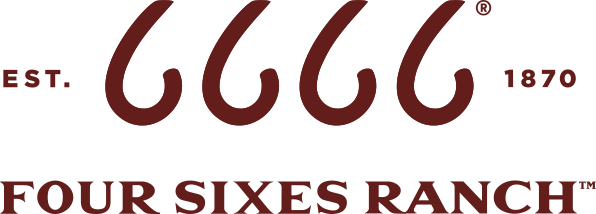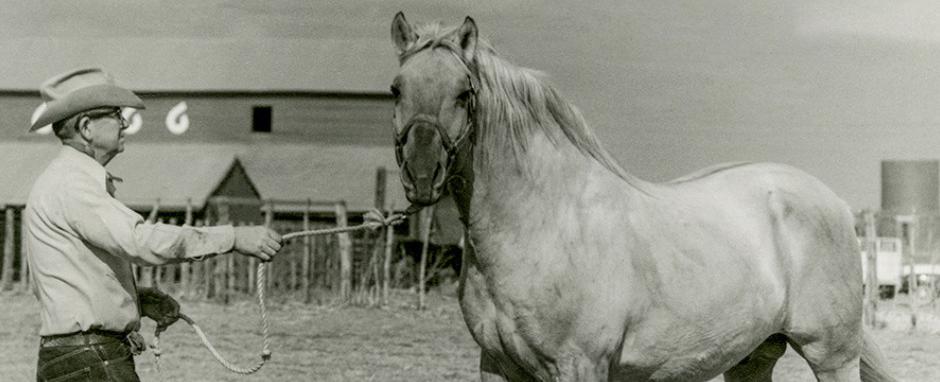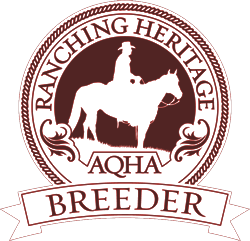Hollywood Gold died in 1964, but he continues to appear in the pedigree of some of the top horses in AQHA record books.
Story by Jim Jennings
The Four Sixes Ranch, headquartered at Guthrie, Texas, has had many outstanding stallions in its 150-year history, but what could be considered the foundation stallion of the ranch was a dun-colored
horse with a light mane and tail, foaled in 1940. The stallion’s name was Hollywood Gold.
Hollywood Gold’s story begins on a pretty spring day in May 1940, when Lige Reed, foreman of the Triangle Ranch near Iowa Park, Texas, was prowling the pastures, checking the 40-some-odd mares that were grazing there. The Triangle was owned by Anne Burnett Hall, who had inherited that ranch, along with the Triangle Ranch near Paducah, Texas, from her father, Tom Burnett. Her grandfather, S. B. “Burk” Burnett, had founded the Four Sixes ranches, and Anne was operating both of them. AQHA had been formed in March of that year, and “Miss Anne,” as she was called in the ranch country of West Texas, had had an instrumental part in that formation, hosting a dinner party at her house the evening before the meeting. Her husband, Jim Hall, had been elected treasurer of the fledgling organization.
Lige was a horseman of the best kind, and when he rode up on a red dun mare with a triangle branded on her jaw and the number 17 on her hip, and a wobbly legged dun colt trying to hide behind her, he stopped to take a look. The mare was about 6 years old and had already produced a couple of colts that promised to be good using horses, so Lige maneuvered around to get a look at this one.
This group of mares had all been bred to a horse called Gold Rush, a 4-year-old palomino by Caliente by Del Rey. Gold Rush had been bred by C. B. Lowry and was foaled in California in 1936. Miss Anne had seen him out there and thought he would be a good cross on her broodmares, so she bought him and brought him to the Triangle as a 2-year old. As Lige was looking the colt over, he noticed right away that he carried the color of his sire and dam, but he noticed something else, too, and it didn’t take him long to pass those thoughts along. That day at noon, when he returned to the ranch headquarters, he told the other men around the dinner table, “Watch that Triangle 17’s colt. Take good care of him. We’ve got a stud horse there.”
But Lige didn’t leave it to the other men to watch Triangle 17’s colt. As spring turned into summer and then into fall, there was many a day that Lige would saddle up and ride through the pasture or drive out in his pickup and just sit and watch the colt as he ran and played with the other weanlings in the pasture. It even got to be a joke among the Triangle cowboys about how much looking after that 17’s colt required. Lige paid them no mind. He was thinking about the coming years, when he would be riding the colt, and then a few years after, when he would be riding foals by him. When someone asked Lige what it was about the colt that he liked so well, the foreman replied, “I just like him, that’s all.”
But a little later, Lige told someone that he had liked the colt from the time he was foaled. He said that he liked his conformation that first day and then got to liking him better and better when he saw how he handled himself. Lige also said that he had always liked the colt’s mother, and he liked Gold Rush. In a 1957 Quarter Horse Journal article, Lige was quoted as saying, “When we brought the colts into headquarters for halter breaking, we found (this one) had a wonderful disposition. He seemed to understand just what we wanted him to do, and he tried to help us get the job done. I was right glad that I hadn’t been disappointed in him.”
When it came time to geld the yearlings, Lige put the dun colt in a distant pen where he could keep an eye on him. He wanted to be sure nobody made a mistake and cut that one. And then when time came to name the little dun, Lige made sure he bore a name to fit his bearing–he called him Hollywood Gold.
As the colt filled out and grew into a 2-year-old, Lige began riding him but used him very lightly. He said that in the beginning, he primarily just used him to bring up the milk cows. However, he said that he was easy to break and went right into cow work just like he had been at it
for years.
For the first two years of Hollywood Gold’s life, Lige talked about him every chance he got. He never let an opportunity pass to praise the colt’s great potential as a cow horse and as a future sire. Then came that day that he figured he had talked too much and bragged too much on the colt. Miss Anne called him into the living room at her Triangle Ranch headquarters house and told him she was sending Hollywood Gold to the Four Sixes at Guthrie to head a band of mares there. Four Sixes manager George Humphreys, who also had an eye for a good horse and had been with the Sixes since 1918, had been trying for several months to get Hollywood Gold, and finally Miss Anne relented.
When the ranch owner told Lige what she was going to do, Lige pleaded, “Please, Miss Anne, get a knife and take my right arm, but leave me the colt.” But her mind was made up, and soon Lige loaded Hollywood Gold in a trailer and delivered him to George at the Sixes.
Before long, George was riding Hollywood Gold on cattle, cutting in the Four Sixes headquarters pens, gathering cows in the ranch’s pastures, roping and working calves. George claimed that Hollywood Gold was the smartest horse he had ever ridden.
In those early years of AQHA, horses had to be inspected in order to be registered. Miss Anne had both Gold Rush and Hollywood Gold’s dam, Triangle Lady 17, inspected as soon after AQHA started registering horses as she could, and in 1944, the AQHA inspector came by the ranch and passed Hollywood Gold for registration. This was really just a formality; since both his sire and dam were
already registered, he was eligible for automatic registration. However, it was important to get it done, because Hollywood Gold’s first foals were hitting the ground in 1944, and this meant they would all be registered, as well.
Hollywood Gold sired 263 registered horses in 22 crops while at the Four Sixes. He was crossed a great deal on mares of Joe Hancock breeding–Tom Burnett had purchased Joe Hancock a few years earlier–and the cowboys who rode them swore they were the finest cattle-handling horses alive. One of those cowboys said, “They took a little more riding to get them there, but when you were done, you had yourself a cow horse.”
Though many of Hollywood Gold’s foals remained on the Four Sixes and were used as ranch horses, a select few made their way into performance and halter arenas across the Southwest. George said once that it was no trouble at all to sell every Hollywood Gold colt as fast as they were weaned, and that the buyers were willing to pay good prices for them. He said, “There are far more people wanting Hollywood Gold foals than we have, either fillies or colts.”
The late J. J. Gibson, who succeeded George Humphreys as Four Sixes general manager, said, “We really didn’t know what we had in Hollywood Gold. I guess we really didn’t know how good he was until he was gone. He was registered as a dun, but I always called him a palomino. He wasn’t tall, maybe 14.2, and weighed somewhat over 1,000 pounds. His eyes are what I remember the most about him. They were unbelievably big, pretty and soft. Even mares who still trace to him today have those eyes.”
J. J. added that, “‘Hollywood’ was always good-natured. His colts were the same way and easy to break. He had tremendous stamina and good feet and legs. He passed most of his positive qualities on to his offspring.” One of the first colts to leave the ranch, Hollywood Snapper, earned 229 cutting points in AQHA competition. Hollywood Cat, earned 403 points. Then there was Mr Gold 95, who was three times in the top 10 at the National Cutting Horse Association Finals, and third in the NCHA world standings in 1965. And, only a year earlier, Hollywood Lin won the 1964 NCHA world championship. In other years, she was twice runner-up at the Finals, and three more times in the top five at the Finals. Then, in 1966, Goldwood won the NCHA Finals in the non-pro division.
In 1969, Matlock Rose rode Cee Bars Joan, who was out of the Hollywood Gold mare Holly Joanie, to win the NCHA Futurity, and in 1988, Sam Rose rode Miss Holly Tip, a granddaughter of Hollywood Gold, to win the NCHA Breeders Cutting. According to the Four Sixes website, “Hollywood Gold is valued, even today, in pedigrees of modern-day ranch and competitive cutting horses.”
The late Dr. Glenn Blodgett, former horse division manager for the Four Sixes, said, “We still had two daughters of Hollywood Gold when I came to the ranch in 1982, and one of those daughters, Miss Holly Peg, quickly came to the front. She’s the dam of Miss Holly Tip, who Sam Rose rode, but then Miss Holly Tip is the dam of Ginnin Attraction, who produced both Playin Attraction and Quahadi, two of the stallions that we have standing at the Four Sixes today.”
Hollywood Gold is also in the pedigree of Sixes Pick, another Four Sixes-bred stallion, and, of course, American Quarter Horse Hall of Famer Hollywood Dun It. Dr. Blodgett said, “The first thing I noticed about the Hollywood Gold horses were those big soft eyes. I think everybody in the horse business knows that a big, soft eye is a sign of intelligence and trainability in a horse, and I certainly think this was a real strong trait of the Hollywood Golds.”
In 1964, at age 24, Hollywood Gold was put down due to failing, arthritic legs. He died in 1964, but he hasn’t been forgotten.












